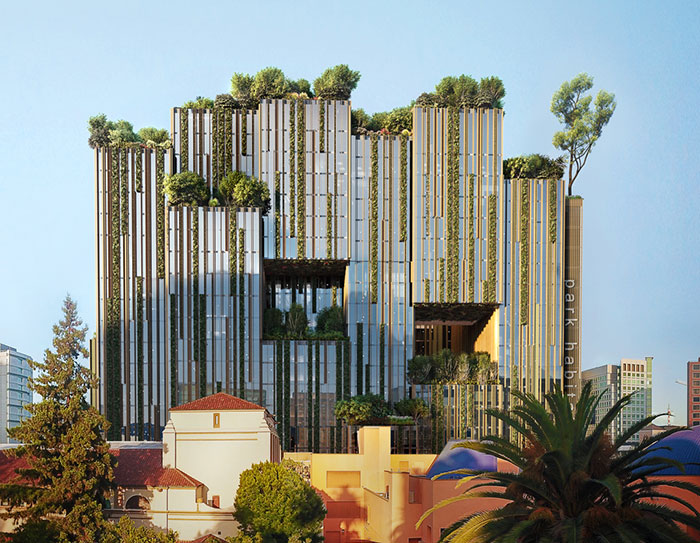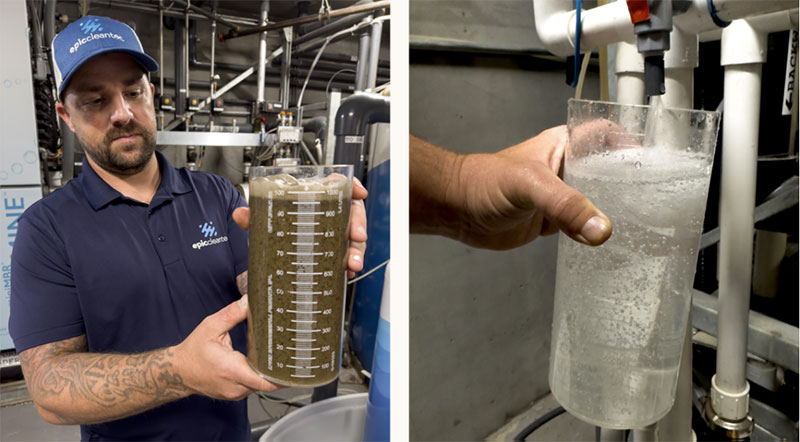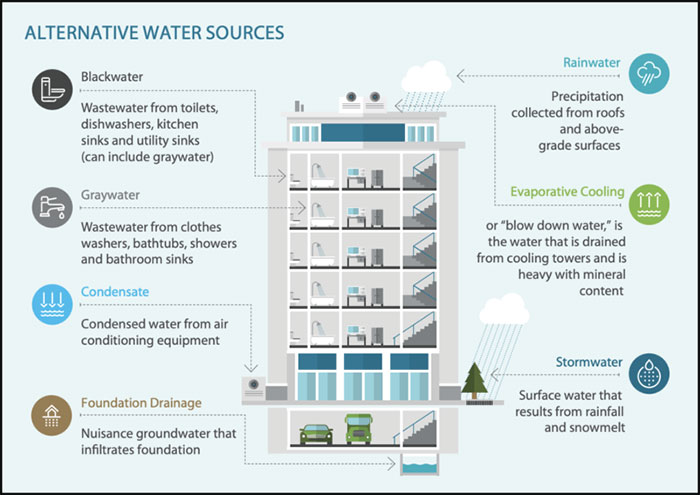These Western Cities Are Turning to “Extreme” Water Recycling
Posted by admin on

A rendering of the Park Habitat office building, now under construction in San Jose, which will use treated wastewater to irrigate a living green wall.
Hayes Davidson/Westbank
This story was originally published by Yale E360 and is reproduced here as part of the Climate Desk collaboration.
In downtown San Francisco, in a cavernous garage that was once a Honda dealership, a gleaming white-and-blue appliance about the size of a commercial refrigerator is being prepared for transport to a hotel in Los Angeles.
There, this unit, called a OneWater System, will be installed in the basement, where its collection of pipes will take in much of the hotel’s graywater—from sinks, showers, and laundry. The system will clean the water with membrane filtration, ultraviolet light, and chlorine, and then send it back upstairs to be used again for nonpotable uses.
And again. And again.
“There is no reason to only use water once,” said Peter Fiske, the executive director of the National Alliance for Water Innovation, a division of the Lawrence Berkeley National Laboratory, in Berkeley. Just as natural systems use and reuse water repeatedly in a cycle driven by the sun, he said, “we now have technologies to enable us to process and reuse water over and over, at the scale of a city, a campus, and even an individual home.”
While centralized water reuse for nonpotable purposes has been around for decades, a trend called the “extreme decentralization of water and wastewater”—also known as “distributed water systems,” or “on-site” or “premise” recycling—is now emerging as a leading strategy in the effort to make water use more sustainable.
The concept is to equip new commercial and residential buildings as well as districts, such as neighborhoods and universities, with on-site recycling plants that will make water for nonpotable use cheaper than buying potable water from a centralized source. By driving down demand for potable water, which is costly to filter, treat, and distribute, the units will help manage water more efficiently. It is, many experts believe, the future of water. Eventually it’s hoped that buildings will be completely self-sufficient, or “water neutral,” using the same water over and over, potable and nonpotable, in a closed loop.
It’s not just a pipe dream. Proof of concept is unfolding in San Francisco, which in 2015 required all new buildings of more than 100,000 square feet to have on-site recycling systems. So far, six blackwater and 25 graywater systems are using the technology, and many others are in the works. (Blackwater comes from toilets, dishwashers, and kitchen sinks; graywater comes from washing machines, showers, and bathtubs.) The headquarters of the San Francisco Public Utilities Commission has a blackwater system, called the Living Machine, that treats its wastewater in engineered wetlands built into the sidewalks around the building, then uses it to flush low-flow toilets and urinals. The process reduces the building’s imported potable supply by 40 percent.
Recycling graywater alone can save substantial amounts of water. Using it to flush toilets and wash clothes reduces demand for new water by about 40 percent. Using recycled water for showers would eliminate another 20 percent of water demand, though the safety of that practice is being researched and is not yet permitted in San Francisco.

Ryan Pulley of Epic Cleantec with untreated and potable treated graywater.
To demonstrate its technology, Epic Cleantec, a water recycling company, has even brewed a beer called Epic OneWater Brew with purified graywater from a 40-story San Francisco apartment building.
With the meagdrought and water crisis on the Colorado, the Rio Grande, and other Western rivers, “extreme decentralization” is making its way to other places in the American West, including Colorado, Texas, and Washington State. And decentralized projects are ongoing in Japan, India, and Australia. There are serious pressures on fresh water supplies around the world, with climate change exacerbating shortages. A recent study found that more than half the world’s lakes have lost significant amounts of water over the last 30 years. By 2050, the UN estimates that 5 billion people could be subjected to water shortages.
“This is the future of water for everybody,” Newsha Ajami, director of Urban Water Policy at Stanford’s Water in the West program, said of decentralized water systems and recycling. “It’s a slow-moving process, but at the end of the day—considering all the scarcity—a lot of communities are going to pick this up as a way of having economic development while having water security.”
San Francisco’s recycling systems are not water neutral. The largest building with an on-site system is the Salesforce Tower, a 61-story office, hotel, and residential tower that opened in 2018 and is the tallest building in San Francisco. Built by the Australian company Aquacell, the system cleans 30,000 gallons of sewage, sink, shower, and other wastewater each day and uses it for irrigation and toilet flushing, saving an estimated 7.8 million gallons of water a year. That’s the equivalent of the annual use of 16,000 San Franciscans, the company says. Outside water is still needed for potable uses. (In New York, the Domino Sugar Refinery redevelopment project, currently under construction on the Brooklyn waterfront, will recycle 400,000 gallons of blackwater a day.)
The San Francisco Public Utilities Commission, the water provider, estimates that there are a total of 48 reuse systems in operation and 29 more projects being planned in the city. By 2040, the agency says, its Onsite Water Reuse program will save 1.3 million gallons of potable water each day.
The technology for these buildings to capture and treat all their water to potable standards already exists. But the safety of direct reuse of recycled wastewater is still being studied, and U.S. regulations so far do not allow that. A fully circular system, in which water is reused on-site for both potable and nonpotable uses, is at least five to 10 years away in this country, experts say.

Alternative water sources available in a typical urban building.
Pacific Institute
Centralized recycled water systems, by contrast, have been used for decades, though they too have rapidly grown as a solution to water shortages. Orange County, California, for example, is home to the world’s largest water recycling facility. It cleans 130 million gallons of blackwater a day in a process called indirect potable reuse. Highly treated wastewater, which would normally have been discharged into the ocean, is put through an advanced three-step purification process that includes micro-filtration, reverse osmosis, and disinfection with ultraviolet light and hydrogen peroxide. The output is injected into nearby groundwater, to be pumped up and treated to drinking-water standards by local utilities.
In water-short Singapore, the massive Changi Water Reclamation Plant cleans and purifies 237 million gallons of wastewater a day to potable standards.
But the new reuse paradigm fundamentally rethinks water systems, localizing them in much the same way that households and districts with rooftop and community solar have transformed energy systems away from centralized power plants.
New buildings and neighborhoods, said Fiske, of the National Alliance for Water Innovation, may someday no longer need to hook up to sewer lines and water supplies. People will be able to build without regard to connections to water infrastructure, simply by using the same water again and again in a virtually closed loop. “The water that falls on the roof in most places in the world will be enough to sustain a home,” predicts Fiske, citing a recent study that found that this approach could save at least 75 percent of water demand.
Premise recycling not only saves water, it can also save the cost of pumping water over long distances and the costs associated with digging up streets for replacement and installation of pipelines. “Water is heavy,” said Fiske, “And we live on a planet with gravity. So use water where you live over and over again.”
While in some situations decentralized systems are expected to save money by reducing the energy needed to pump water, in others situations they could require more electricity to pump water through a building.
The increased prevalence of water recycling will allow water to be cleaned to varying standards—or different “flavors”—according to its intended use, a concept called “fit for purpose.” Water to flush toilets, for example, doesn’t need to be cleaned as thoroughly as drinking water.
The recycling systems being built in San Francisco are widely considered a success, and representatives from water-stressed cities around the world have come here to study the approach.
Epic Cleantec has designed a system that will provide 30,000 gallons a day for the Park Habitat office building, under construction in San Jose. Its blackwater system will be used to irrigate a living green wall on the tower’s 20-story exterior. The system collects water from rain, cooling towers, showers, toilets, and sinks, then circulates it through a multistep treatment process in the basement. The solids are separated, sterilized, and turned into a soil amendment.
“San Francisco has written the playbook and de-risked the whole process” by smoothing the regulations needed to build these systems, said Aaron Tartakovsky, who founded Epic Cleantec with his father, Igor, and is its CEO. “The technology to do this has been around for a long time. What has prevented the adoption of the technology has been regulatory hurdles. Without any established framework there was no way to get this done. What cities and states are doing is coming up with a clear playbook for how these systems can be operated safely and efficiently.”
Tartakovsky said the systems Epic Cleantec is building cost from a few hundred thousand to a few million dollars. The return on investment takes about seven years, he says. After that, there are considerable ongoing savings on water and sewer costs that vary from building to building.
Heather Cooley, director of research for the Pacific Institute in Oakland, an independent organization that studies water sustainability, and an author of a report on distributed systems and water resilience, believes premise systems are essential for California’s water future. “These on-site and distributed systems are an exciting addition to the range of tools to meet weather challenges,” she said. “They will help build resilience.” However, she added, “there’s no silver bullet. They’re not going to be applied in every building everywhere.”
It might seem counterintuitive that the San Francisco Public Utilities Commission requires new buildings to reduce their consumption of city water: After all, the commission is in charge of selling that resource. But San Francisco has a policy of densification in the urban core. As three- and four-story buildings are replaced with 10- and 12-story buildings, the cost of building new water infrastructure and finding new water sources is soaring.
Premise recycling is also taking place in what are known as districts. The University of California, Davis, has a blackwater system used for irrigation, and new neighborhoods are rising with their own closed-loop recycling systems. In San Diego, for example, developers are building a large district system to recycle blackwater at a shopping center that’s being converted into an office campus.
“Neighborhood scale is the right scale for sustainability” for recycled water, said Claire Maxfield, director of the San Francisco office of Atelier Ten, a London-based architecture firm.
Maxfield led the sustainability team that helped design an 11-acre mixed-use district system for Mission Rock, a neighborhood now under construction next to the San Francisco Giants ballpark. It will collect blackwater from a main sewer, filter it, then send it to all 17 of the neighborhood’s buildings to be used for irrigation and toilet flushing. “It works really well, and it works really cost effectively” at the neighborhood scale, said Maxfield. “It shares the cost, it’s good for resilience and environmental justice. It’s better than telling everybody to solve this on their own.”
A recent study found this approach to water recycling adds about 6 percent to the cost of a single home and 12 percent to the cost of a multifamily dwelling. But as the number of people using these systems increases, economies of scale come into play, making recycled water far less expensive than city water.
The Hydraloop, created in Holland, is one home-based technology on the market, a kind of “water washing” machine. It recycles up to 95 percent of a household’s water, disinfecting shower and washing machine flows to irrigate lawns, flush toilets, and fill swimming pools. Overall water consumption declines by 25 to 45 percent. A company in Vancouver makes a product called RainStick, which recycles shower water over and over while you shower.
What are the barriers to even wider-scale residential changes? The yuck factor, experts say. “When we talk about reuse there’s a lot of fear” among builders and architects, said Maxfield, though she believes they can be overcome.
